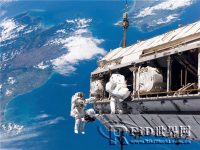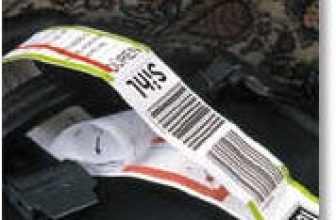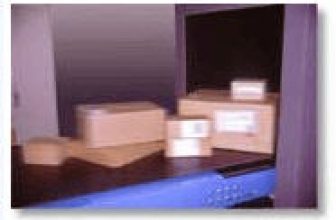
NASA uses surface acoustic wave tags to inventory items on space stations
[ad_1]
Astronauts working on the International Space Station often spend a long time dealing with simple daily tasks, such as changing clothes and brushing their teeth. In a weightless state in space, clothing and personal hygiene products, even the astronauts themselves, will float everywhere, and some simple actions often take a lot of time to complete.
According to regulations, the astronaut of the space station must regularly count his belongings in order to timely replenish the materials needed for the next mission. In weightlessness, it often takes astronauts a lot of time to count items. They couldn’t put the items in their personal duffel bags on the table as if they were on the ground, and then count them one by one; instead, he had to put all the items in other bags and record their types and quantities while keeping them one by one. Putting back the luggage bag, this process usually takes 30 minutes.

NASA International Space Station
Tim Brown is a NASA data integration system manager. He said that the space agency initially considered attaching RFID tags to each item in the luggage bag and using RFID readers to quickly read items instead of manual inventory. NASA also hopes that RFID tags can replace bar codes to track spare parts and other expensive and important hardware in the space station. However, after more than a year of testing and research, NANA found that if passive RFID tags are used, the metal or liquid components in the tracked items will cause interference to the tags. The cost of active tags may not be suitable for tracking consumer products.
Eventually the project was suspended, Brown said, until they tried RF SAW (Surface Acoustic Wave Tag). SAW tags are known for their ability to work normally on metals and liquids. RF SAW is a label manufacturer based in Dallas that uses surface acoustic wave technology. The difference from the silicon chip is that the SAW tag contains a piezoelectric crystal, which is like an integrated circuit in a silicon tag. It is connected to an antenna and can receive the RF signal from the reader and return the signal. The surface acoustic wave tag has a transducer that converts the received RF signal into sound waves and propagates on the surface of the piezoelectric crystal. The transducer converts the sound wave signal into an RF signal, and then transmits the tag data to the reader.

SAW label structure
When a SAW tag is manufactured, there are many tiny metal reflectors attached to the piezoelectric crystal. The reflector arrangement of each label is different. When the sound wave propagates in the piezoelectric crystal, it will be converted into a unique ID number by the digital signal processor of the reader according to the pattern generated by the reflector. Although metals and liquids still slow the reader’s emission of the 2.45 GHz RF signal that activates the SAW tag, the piezoelectric crystal in the tag consumes much less signal energy than an integrated circuit, so that the surface acoustic wave tag can generate stronger signals than silicon tags. The backscattered signal overcomes the slowing effect of metals and liquids.

The working principle of SAW tags
This fall, NASA has a six-month aviation mission. At that time, the uniforms and hygiene items in each astronaut’s duffel bag will be affixed with RF sound wave tags. The ID number of the tag represents each item in the database. During the mission, astronauts can regularly use readers or PDA devices to read the items in the luggage bag. The reader collects the ID number of the read tag and downloads the data to the NANA information system. The astronaut will then manually count the items in the duffel bag. The list of items read by the RF SAW system and the manual list obtained manually will be sent to the ground through the NASA satellite communication system.
If the test in the fall proves to be successful, NASA will continue to expand their test scale. NASA hopes that the tags will have a stable reading distance and reading rate.
In the space test, NASA will also put RF SAW products into their standard and internal certification tests to see if the tag signal will interfere with the frequency bands or other types of communication methods currently used by NASA.
NANA said that if the time required to inventory items can be reduced from the original 30 minutes to 20 seconds, then astronauts can spend more time conducting experiments.
tips: The SAW tag can be regarded as the second generation coreless RFID tag, which is composed of an interdigital transducer and a number of reflectors. The two buses of the transducer are connected to the antenna of the electronic tag. The antenna of the RFID reader/writer periodically sends high-frequency interrogation pulses. Within the receiving range of the electronic tag antenna, the received high-frequency pulses are converted into surface acoustic waves by the interdigital transducer and propagate on the crystal surface. The reflector group partially reflects the incident surface wave and returns to the interdigital transducer, which in turn converts the reflected acoustic pulse train into a high-frequency electric pulse train. If the reflector group is designed according to a specific rule, so that the reflected signal represents the specified code information, then the reflected high-frequency electric pulse train received by the reader will carry the specific code of the article, and it will be demodulated and processed. , To achieve the purpose of automatic identification. Therefore, the RFID system based on surface acoustic wave SAW technology can measure the tag position, running direction, and tag temperature by itself. In addition, SAW labels can withstand the test of safety and safety-related processes-including high temperature, high energy X-ray or gamma ray sterilization.
[ad_2]





